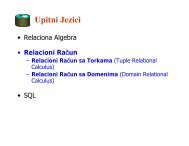You also want an ePaper? Increase the reach of your titles
YUMPU automatically turns print PDFs into web optimized ePapers that Google loves.
Description of work<br />
WP Leader: BGDUNI<br />
T2.1 HW Infrastructure (TL: BGDUNI) – The common idea is to use the standard<br />
hardware for core implementation of this system. That means that most of the system should<br />
run on typical server hardware that is capable to satisfy performance and storage<br />
requirements. The only exception is the specific hardware for the potential acceleration of<br />
certain blocks (DMS) that will be implemented with FPGA technology, if analysis shows that<br />
this acceleration is necessary. Also, in this task it will be considered all hardware devices<br />
(sensor nodes, mobile and smart phones...) that could be either provider of input data for the<br />
system, or just used for interaction with the use<strong>rs</strong> (display of information, request for<br />
information). Outcome of this task is important for specification of communication<br />
infrastructure in T2.2 as well as for software specification in T2.3. As a result of activities in<br />
this task, it will be create the report that discusses all hardware devices considered for using<br />
in this project, with specification of hardware requirements necessary for system built and<br />
specific acceleration hardware.<br />
T2.2 Communications infrastructure (TL: BGDUNI) – This system architecture should<br />
support integration with input data supplie<strong>rs</strong> through different communication channels, and<br />
in the same time to provide response to the use<strong>rs</strong> via various communication protocols and<br />
standards. This list of communication channels and protocols includes WSN protocols<br />
(ZigBee, Bluetooth, IEEE 802.15.4, or its modifications), mobile oriented services (GSM,<br />
SMS, GPRS, alarms, page<strong>rs</strong>), Internet services (Cloud, GIS, Finances, Digital Marketing,<br />
public available web services). In the same time it is necessary to publish information through<br />
wide possible protocols and standards (HTML, WML, web services, RDF, REST). Since this<br />
list of communication protocols could be very long, the main objective of this task is to<br />
specify principle mechanism of connecting various data sources (communication protocols<br />
and standards) to our system using plug-in mechanism. Practically, it is a definition how to<br />
interpret received data and to store them to the internal unified format enabled for later<br />
searching and retrieving from higher blocks in the architecture. Similarly, necessary protocols<br />
and formats for publishing customer information should be specified. Typically, this should<br />
include a well known format as HTML, WML, specification for offered web services,<br />
specification for the semantic web structured data, description of the alerting or subscribing<br />
services on certain information through asynchronous web services and similar. In order to<br />
achieve interoperability with other systems, it will be consider formats with semantically<br />
annotated data that is suitable for an easy exchange of information (RDF). The outcome of<br />
this task is in correlation with the results of WP1 (use case analysis) and also with T2.1. and<br />
T2.3. The result of this task is the report with the specification of communication channels<br />
and protocols used for input and output to our system.<br />
T2.3 SW Infrastructure (TL: BGDUNI) – The objective of this task is to specify all<br />
necessary software components and interfaces among them, while considering all software<br />
platforms that could be used. This system consists of several software components each<br />
responsible for different tasks. The common idea for the system architecture is to use service<br />
oriented architecture. But, as a common ground and most likely the most important part of the<br />
whole system is the system integration layer, responsible for integrating of all available<br />
sources of data while storing collected data in the common data format. Experience from the<br />
previous projects (semantic sensor layer - integration of sensor networks in Prosense FP7<br />
project) will help in specification of this part. The idea is to use data format which saves data<br />
values, but also keeps additional information (time, location, and othe<strong>rs</strong>), and also data about<br />
data types which is stored in appropriate meta data. With this approach, collected data could<br />
be retrieved and semantically searched using an easy and uniform interface, which hides<br />
specifics of the source and format of original data. All relevant paramete<strong>rs</strong> could be saved on<br />
this way and used later for processing (tracking of relevant events in the system, user<br />
behavior, usage patterns…). This will be useful for all higher blocks in architecture that<br />
should perform very complex algorithms on gathered data. These complex components in the<br />
system include:<br />
Software agents, responsible for monitoring processes in the system based on the data from<br />
various sources<br />
Data mining system (DMS) that performs various complex algorithms (based on neural<br />
networks, decision trees...) in order to predict requests to the system, input data, and hence<br />
response of the system. If analysis in this task shows that performing necessary algorithms


![Proposal - start [kondor.etf.rs]](https://img.yumpu.com/3715277/56/500x640/proposal-start-kondoretfrs.jpg)


![Anytime, Anywhere Learning Behavior Using a ... - start [kondor.etf.rs]](https://img.yumpu.com/3996703/1/184x260/anytime-anywhere-learning-behavior-using-a-start-kondoretfrs.jpg?quality=85)